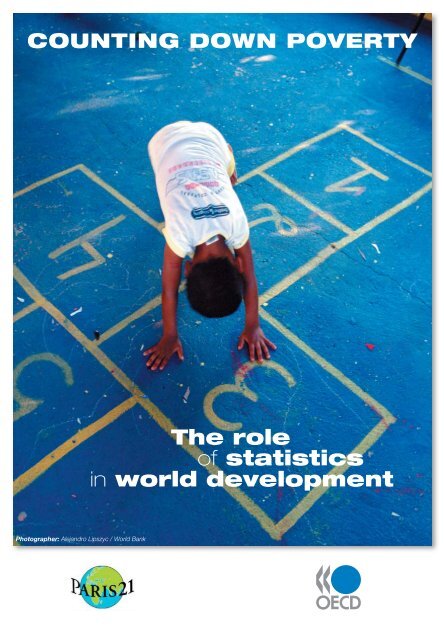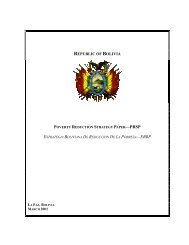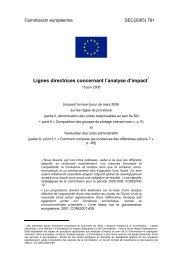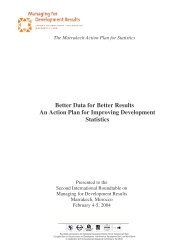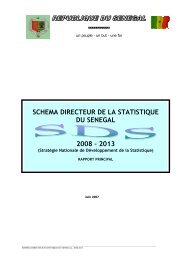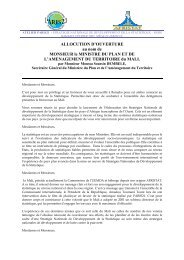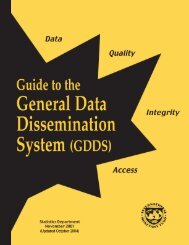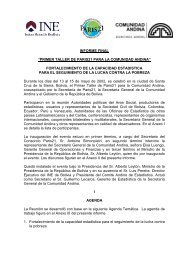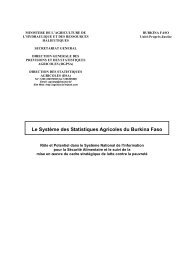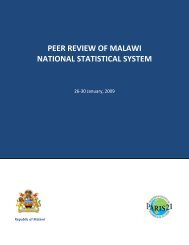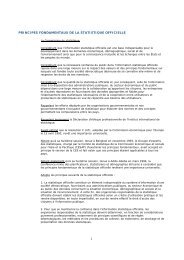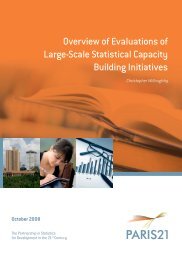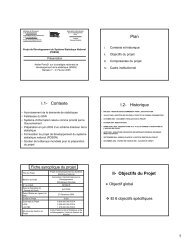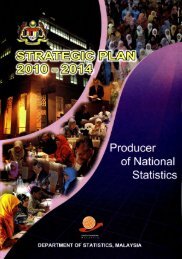The role of statistics in world development - Paris21
The role of statistics in world development - Paris21
The role of statistics in world development - Paris21
- No tags were found...
Create successful ePaper yourself
Turn your PDF publications into a flip-book with our unique Google optimized e-Paper software.
COUNTING DOWN POVERTY<strong>The</strong> <strong>role</strong><strong>of</strong> <strong>statistics</strong><strong>in</strong> <strong>world</strong> <strong>development</strong>Photographer: Alejandro Lipszyc / World Bank
Count<strong>in</strong>g Down Poverty<strong>The</strong> <strong>development</strong> contextCountry strategies and frameworksMost low-<strong>in</strong>come countries are develop<strong>in</strong>g national policy frameworks — such asPoverty Reduction Strategies and macroeconomic and sector management frameworks— as part <strong>of</strong> their policy processes to deliver <strong>development</strong> progress and reduce poverty.<strong>The</strong>se strategies and frameworks highlight the need for <strong>statistics</strong> to provide a strongfoundation for the diagnosis <strong>of</strong> poverty and the <strong>development</strong> situation as well as tomonitor the effectiveness <strong>of</strong> policy implementation. So, <strong>statistics</strong> are needed to helpdrive the outcomes that the policies are aim<strong>in</strong>g at, not just to measure progresstowards those outcomes. National Strategies for the Development <strong>of</strong> Statistics(NSDS) provide a framework for build<strong>in</strong>g and susta<strong>in</strong><strong>in</strong>g capacity to producenational <strong>statistics</strong>.Millions <strong>of</strong> people liv<strong>in</strong>g on less than $1 a day <strong>in</strong> 2003(based on most recent estimates per country)South Asia 472Sub-Saharan Africa 320East Asia and Pacific 213- <strong>of</strong> which Ch<strong>in</strong>a 179Lat<strong>in</strong> America and Caribbean 49Europe and Central Asia 9Middle East and North Africa 5Total 1,068[ ]“Sound data representa key weapon<strong>in</strong> the battle aga<strong>in</strong>st poverty”Tadao Ch<strong>in</strong>o, former President, Asian Development Bank4
Count<strong>in</strong>g Down PovertyMillennium Development goals, targets and <strong>in</strong>dicatorsHeads <strong>of</strong> state agreed upon the MDGs and global targets for <strong>in</strong>ternational <strong>development</strong><strong>in</strong> September 2000 dur<strong>in</strong>g the UN Millennium Summit, with the aim to dramatically reduce<strong>world</strong> poverty by 2015. <strong>The</strong> MDGs have proved to be a powerful tool for build<strong>in</strong>g the politicalwill needed, and the Goals provide a focus for both government and civil society. But tomeet the Goals, comprehensive <strong>in</strong>formation is needed to monitor progress towardsnational and <strong>in</strong>ternational targets, to <strong>in</strong>form policies and <strong>development</strong> strategies, and tospur the <strong>in</strong>ternational community <strong>in</strong>to action. A set <strong>of</strong> <strong>in</strong>dicators has been developed tomeasure progress towards the MDGs and targets and, <strong>in</strong> turn, the <strong>in</strong>dicators rely on<strong>in</strong>formation from robust and reliable national statistical systems. MDG CountryReports document the progress <strong>in</strong> <strong>in</strong>dividual countries and assess each country’s statisticalcapacity as a fundamental part <strong>of</strong> weigh<strong>in</strong>g whether the country is likely to meet its ownMDG targets.Millennium Development GoalsGoal 1: Eradicate extreme poverty and hungerGoal 2: Achieve universal primary educationGoal 3: Promote gender equality and empower womenGoal 4: Reduce child mortalityGoal 5: Improve maternal healthGoal 6: Combat HIV/AIDS, malaria and other diseasesGoal 7: Ensure environmental susta<strong>in</strong>abilityGoal 8: Develop a global partnership for <strong>development</strong>Aid EffectivenessGood <strong>statistics</strong> help donors by <strong>in</strong>form<strong>in</strong>g aid allocation decisions and by monitor<strong>in</strong>gthe use <strong>of</strong> aid and <strong>development</strong> outcomes. <strong>The</strong> Paris Declaration on Aid Effectiveness(March 2005) recognises the need for better <strong>statistics</strong> for more effective aid. M<strong>in</strong>isters <strong>of</strong>developed and develop<strong>in</strong>g countries responsible for promot<strong>in</strong>g <strong>development</strong> and Heads<strong>of</strong> multilateral and bilateral <strong>development</strong> <strong>in</strong>stitutions stressed the need to:1. Put control <strong>in</strong> the hands <strong>of</strong> partner countries,2. Align donor support with partner countries’ <strong>development</strong> strategies, <strong>in</strong>stitutionsand procedures, and6
<strong>The</strong> <strong>role</strong> <strong>of</strong> <strong>statistics</strong> <strong>in</strong> <strong>world</strong> <strong>development</strong>3. Harmonise donor actions to be collectively more effective,4. While monitor<strong>in</strong>g implementation and outcomes with<strong>in</strong> a framework <strong>of</strong> mutualaccountability between <strong>development</strong> partners............Acknowledg<strong>in</strong>g the need for better <strong>statistics</strong> for more effective aid.Evidence for all: DFID <strong>statistics</strong> strategyAs part <strong>of</strong> their strategy to improve aid effectiveness, statisticians at the UK’sDepartment for International Development (DFID) will ensure the effective use <strong>of</strong><strong>statistics</strong> and evidence by:• Encourag<strong>in</strong>g everyone <strong>in</strong> DFID to monitor progress (at all levels such as project,programme and policy) as part <strong>of</strong> rout<strong>in</strong>e management behaviour — and to usethat <strong>in</strong>formation <strong>in</strong> decision-mak<strong>in</strong>g.• Improv<strong>in</strong>g DFID data collection systems and quality control.• Improv<strong>in</strong>g dissem<strong>in</strong>ation and communication <strong>of</strong> evidence and results.Governments and donors are more focussed than ever before on the desiredoutcomes and impact <strong>of</strong> their <strong>development</strong> efforts, and on us<strong>in</strong>g <strong>in</strong>formation to improvepolicy and decision-mak<strong>in</strong>g. Citizens, meanwhile, need <strong>statistics</strong> to hold their governmentsto account. So, <strong>statistics</strong> are important to <strong>development</strong> progress, not just to monitorprogress but to help drive the outcomes that the <strong>statistics</strong> are measur<strong>in</strong>g. But recognis<strong>in</strong>gthe critical <strong>role</strong> <strong>of</strong> <strong>statistics</strong> is one th<strong>in</strong>g; do<strong>in</strong>g someth<strong>in</strong>g about it is another. Muchmore rema<strong>in</strong>s to be done to ensure the better use <strong>of</strong> better <strong>statistics</strong> as part <strong>of</strong>the enabl<strong>in</strong>g environment for <strong>development</strong>.Countries need both f<strong>in</strong>ancial and technical assistance, <strong>in</strong> addition to their ownresources. This will be a long-term process, which will need to be both scaled-up andsusta<strong>in</strong>ed. And countries need this support to be well coord<strong>in</strong>ated and effective. A 2005review <strong>of</strong> donor support for statistical capacity build<strong>in</strong>g <strong>in</strong> Africa by the Partnership <strong>in</strong>Statistics for Development <strong>in</strong> the 21 st Century (PARIS21) showed that this is not alwaysthe case, with some donors remark<strong>in</strong>g that there is <strong>in</strong>sufficient donor collaboration andthat programmes are not always designed with capacity build<strong>in</strong>g as an objective.Coord<strong>in</strong>ation is a key consideration with, for <strong>in</strong>stance, 13 donors assist<strong>in</strong>g <strong>statistics</strong> <strong>in</strong>Mozambique, 11 <strong>in</strong> Tanzania, 10 <strong>in</strong> Uganda and 9 <strong>in</strong> Cape Verde. That is not to say thatcoord<strong>in</strong>ation is not work<strong>in</strong>g well <strong>in</strong> any <strong>of</strong> these countries, just that it is an issue.7
Count<strong>in</strong>g Down PovertyPhotographer: Curt Carnemark / World Bank[ ]“Information gives youthe power to makethe right decisions”Dr Roberto Tapia Conyer, Vice-M<strong>in</strong>ister, M<strong>in</strong>istry <strong>of</strong> Health, MexicoBuild<strong>in</strong>g statistical capacity for better <strong>development</strong> resultsExperience has shown that <strong>statistics</strong> can best be improved through a comprehensivestrategic approach, aimed both at produc<strong>in</strong>g better data now as well as build<strong>in</strong>g susta<strong>in</strong>ablestatistical capacity for the future — rather than through the <strong>of</strong>ten piecemeal efforts <strong>of</strong> thepast which tended to produce <strong>statistics</strong> but not the capacity to replicate them <strong>in</strong> the future.In most develop<strong>in</strong>g countries, f<strong>in</strong>ancial resources are very limited, and careful decisionsneed to be made about how best to develop <strong>statistics</strong> most effectively and efficiently. Thiscan be facilitated through the design and implementation <strong>of</strong> strategic statistical plans,National Strategies for the Development <strong>of</strong> Statistics (NSDSs), aligned with the widernational policy frameworks and strategies. It also makes sense to build on what exists andwhat is already be<strong>in</strong>g developed through programmes such as the IMF’s General DataDissem<strong>in</strong>ation System (GDDS), <strong>in</strong> which a large number <strong>of</strong> countries already participate,and the work <strong>of</strong> the Health Metrics Network (HMN), to expand the availability and use<strong>of</strong> timely and accurate country-based health <strong>in</strong>formation systems.8
<strong>The</strong> <strong>role</strong> <strong>of</strong> <strong>statistics</strong> <strong>in</strong> <strong>world</strong> <strong>development</strong>Ma<strong>in</strong>stream<strong>in</strong>g strategic plann<strong>in</strong>g <strong>of</strong> <strong>statistics</strong>Ma<strong>in</strong>stream<strong>in</strong>g strategic plann<strong>in</strong>g <strong>of</strong> <strong>statistics</strong> is the first, and overarch<strong>in</strong>g, action <strong>in</strong>the Marrakech Action Plan for Statistics (MAPS), agreed at the Second InternationalRoundtable on Manag<strong>in</strong>g for Development Results that was held <strong>in</strong> Marrakech, Morocco,<strong>in</strong> February 2004. MAPS stressed the <strong>in</strong>tent <strong>of</strong> PARIS21 partners to help develop<strong>in</strong>gcountries to establish susta<strong>in</strong>able statistical capacity and national commitment to <strong>statistics</strong>.MAPS aims to accelerate progress <strong>in</strong> improv<strong>in</strong>g <strong>development</strong> data, based on actions tohelp both national and <strong>in</strong>ternational statistical agencies. <strong>The</strong> actions were brought togetherthrough collaboration with a number <strong>of</strong> partners, and built on the results <strong>of</strong> a PARIS21task team which looked at ways to improve <strong>statistics</strong> for monitor<strong>in</strong>g <strong>development</strong> goals.<strong>The</strong> six actions <strong>of</strong> the Marrakech Action Plan for Statistics<strong>The</strong> first set <strong>of</strong> actions addresses national needs:1. Ma<strong>in</strong>stream strategic plann<strong>in</strong>g <strong>of</strong> <strong>statistics</strong>2. Prepare for the 2010 population census round3. Increase <strong>in</strong>vestment <strong>in</strong> <strong>statistics</strong><strong>The</strong> second set addresses <strong>in</strong>ternational responsibilities:4. Set up an International Household Survey Network5. Improve MDG monitor<strong>in</strong>g6. Improve <strong>in</strong>ternational accountability <strong>in</strong> <strong>statistics</strong><strong>The</strong> objective <strong>of</strong> ma<strong>in</strong>stream<strong>in</strong>g strategic plann<strong>in</strong>g <strong>of</strong> <strong>statistics</strong> is to enable alldevelop<strong>in</strong>g countries to base their statistical <strong>development</strong> around National Strategies forthe Development <strong>of</strong> Statistics as an <strong>in</strong>tegral part <strong>of</strong> <strong>development</strong> processes. MAPSendorsed the PARIS21 target for all low-<strong>in</strong>come countries to implement NSDSs with a viewto produc<strong>in</strong>g better national <strong>statistics</strong> by the time <strong>of</strong> the next Millennium review <strong>in</strong> 2010.In 2007, the emphasis is mov<strong>in</strong>g from help<strong>in</strong>g countries to design their NSDSs to help<strong>in</strong>gwith implementation.11
Count<strong>in</strong>g Down PovertyNational Strategies for the Development <strong>of</strong> Statistics (NSDS)<strong>The</strong> added value <strong>of</strong> the NSDS approach is that it looks at statistical capacity build<strong>in</strong>gthrough a <strong>development</strong> and management lens; and looks at <strong>development</strong> policyand best management practices through a statistical lens — all <strong>in</strong> pursuit <strong>of</strong> better<strong>development</strong> outcomes. It sets strategic plann<strong>in</strong>g and priority sett<strong>in</strong>g with<strong>in</strong> thecontext <strong>of</strong> the entire statistical system, <strong>in</strong>clud<strong>in</strong>g <strong>statistics</strong> produced by l<strong>in</strong>e m<strong>in</strong>istries,as well as address<strong>in</strong>g essential organisational and <strong>in</strong>stitutional issues.An NSDS will provide a vision for where the National Statistical System (NSS) shouldbe <strong>in</strong> five to ten years. It also provides a robust framework and action plan for build<strong>in</strong>gstatistical capacity to meet both current and future data needs across all sectors, sothat improvement plans can focus on areas where capacity build<strong>in</strong>g is needed most.It builds on exist<strong>in</strong>g work and provides a coherent framework for fund<strong>in</strong>g decisionsby governments and for coord<strong>in</strong>at<strong>in</strong>g the contributions <strong>of</strong> external donors.NSDSs may take many forms, depend<strong>in</strong>g on country experiences and progress.A good strategy, adequately funded and successfully implemented, can make a bigdifference to the performance <strong>of</strong> an NSS and help those countries locked <strong>in</strong> thevicious cycle <strong>of</strong> under-fund<strong>in</strong>g and under-performance to break free.Many countries have found that they need strong leadership to see the strategicplann<strong>in</strong>g processes through and to ga<strong>in</strong> the necessary high-level government supportto implement their strategic plans. Coord<strong>in</strong>ation across the NSS and coherence <strong>of</strong>donor support is essential. To be fully effective, all national and <strong>in</strong>ternational statisticalactivities should be placed with<strong>in</strong> the context <strong>of</strong> a country’s NSDS.Overall, out <strong>of</strong> 105 countries covered by a recent PARIS21 report (April 2006), 34 havestrategies <strong>in</strong> place while 54 are at various stages <strong>in</strong> prepar<strong>in</strong>g strategies. But another17 neither have strategies <strong>in</strong> place nor have started to design one, though a number<strong>of</strong> these countries have expressed their <strong>in</strong>tention to do so. It should be noted that somecountries with exist<strong>in</strong>g strategies also <strong>in</strong>tend to update and develop them, follow<strong>in</strong>gthe NSDS approach.12
<strong>The</strong> <strong>role</strong> <strong>of</strong> <strong>statistics</strong> <strong>in</strong> <strong>world</strong> <strong>development</strong>Help<strong>in</strong>g countries to prepare for the 2010 Census RoundPopulation censuses are the backbone <strong>of</strong> any national statistical system and are vitalto set basel<strong>in</strong>es at least every decade. <strong>The</strong>y establish the size, nature and location <strong>of</strong> a country’spopulation. <strong>The</strong>y provide essential data for monitor<strong>in</strong>g progress towards the MillenniumDevelopment Goals; allow sound estimates <strong>of</strong> the country as a whole to be made from samplesurveys; and provide the foundation for decid<strong>in</strong>g on the structure for political representation.<strong>The</strong>y also provide key <strong>in</strong>formation on the location and composition <strong>of</strong> the population, afundamental need, for <strong>in</strong>stance, to plan efforts to provide education and health for all.<strong>The</strong> complexity and cost <strong>of</strong> censuses, and their high political pr<strong>of</strong>ile, put them <strong>in</strong> adifferent league from other exercises run by national <strong>statistics</strong> <strong>of</strong>fices. Populations aresubstantially larger than they were ten years ago so costs have risen, while it is <strong>of</strong>ten moredifficult to attract funds for censuses than before.MAPS activities <strong>in</strong>clude f<strong>in</strong>d<strong>in</strong>g ways to reduce the cost <strong>of</strong> census-tak<strong>in</strong>g; improv<strong>in</strong>gmethods to make <strong>in</strong>ter-census population estimates; assist<strong>in</strong>g countries <strong>in</strong> advocat<strong>in</strong>g forthe importance <strong>of</strong> census-tak<strong>in</strong>g, for secur<strong>in</strong>g fund<strong>in</strong>g, and for plann<strong>in</strong>g; and provid<strong>in</strong>gcountries with technical knowledge and guidance.[ ]“Whatever we do,we are guided by figures”Yoweri Museveni, President <strong>of</strong> Uganda13
Count<strong>in</strong>g Down PovertyCarry<strong>in</strong>g out the 2006 population census <strong>in</strong> Nigeria — the <strong>role</strong> <strong>of</strong> the ECCensus tak<strong>in</strong>g <strong>in</strong> Nigeria, the most populous country <strong>in</strong> Africa, is a complex, difficultand controversial task. With an election due <strong>in</strong> Nigeria <strong>in</strong> 2007, a successful censuswas carried out <strong>in</strong> early 2006. <strong>The</strong> census not only enables the constitutionallyrequired demarcation <strong>of</strong> election areas, but also helps Nigerians build much-neededtrust <strong>in</strong> Nigerian <strong>in</strong>stitutions, electoral or otherwise. To support this task, the EuropeanCommission signed a F<strong>in</strong>anc<strong>in</strong>gAgreement for the Census SupportProgramme at the end <strong>of</strong> 2004,which is implemented through aContribution Agreement signed withthe United Nations DevelopmentProgramme (UNDP). This Nigerianprogramme will strengthenevidence-based policy-mak<strong>in</strong>g,people-oriented service delivery andPhotographer: Trevor Samson / World Banka culture <strong>of</strong> transparency andaccountability.<strong>The</strong> EC contribution <strong>of</strong> Euro 116.5 million from 2004–2007 is f<strong>in</strong>anc<strong>in</strong>g payments toover 800,000 census staff. Tra<strong>in</strong><strong>in</strong>g for census staff, the provision <strong>of</strong> censusquestionnaires, data captur<strong>in</strong>g and process<strong>in</strong>g technology, plus the support fornational census monitor<strong>in</strong>g projects and external monitor<strong>in</strong>g missions — all these actionsequally enhance the credibility <strong>of</strong> the census.<strong>The</strong> National Population Commission (NPopC) <strong>in</strong> Nigeria put <strong>in</strong> place a strategy topromote gender equity throughout the census-tak<strong>in</strong>g process. Once data becomeavailable, they will form the basis <strong>of</strong> knowledge on pert<strong>in</strong>ent demographic, socioeconomicand cultural issues for many years to come. <strong>The</strong> census helps Nigeria ensurethat policy decisions and monitor<strong>in</strong>g efforts are rooted <strong>in</strong> sound <strong>in</strong>formation and canthus be better implemented to the greater benefit <strong>of</strong> its population.14
<strong>The</strong> <strong>role</strong> <strong>of</strong> <strong>statistics</strong> <strong>in</strong> <strong>world</strong> <strong>development</strong>HMN's MoVE <strong>in</strong>itiativeA fundamental prerequisite for, and sign <strong>of</strong>, good governance is knowledge <strong>of</strong>population size, structure and change — births, deaths and causes <strong>of</strong> death. <strong>The</strong>Millennium Development Goals (MDGs), several <strong>of</strong> which relate to mortality, have drawnthe attention <strong>of</strong> policy makers at national and global levels to the need for accurateand timely population data. Yet such <strong>in</strong>formation is lack<strong>in</strong>g <strong>in</strong> the majority <strong>of</strong> develop<strong>in</strong>gcountries, where births and deaths too <strong>of</strong>ten go unregistered and causes <strong>of</strong> deathrema<strong>in</strong> poorly understood.Tackl<strong>in</strong>g this strik<strong>in</strong>g imbalance between demand and supply is one <strong>of</strong> the objectives<strong>of</strong> the Health Metrics Network. To this end, HMN is <strong>in</strong>volved with other partners <strong>in</strong>launch<strong>in</strong>g an <strong>in</strong>ternational advocacy and research effort to improve the coverage andquality <strong>of</strong> vital <strong>statistics</strong> — the Monitor<strong>in</strong>g <strong>of</strong> Vital Events (MoVE) <strong>in</strong>itiative. Both theneed and the responsibility for population <strong>statistics</strong> extend well beyond the health sectorand key partners <strong>in</strong> the <strong>in</strong>itiative <strong>in</strong>clude national <strong>statistics</strong> <strong>of</strong>fices, local governmentand <strong>in</strong>terior m<strong>in</strong>istries as well as the multilateral statistical and <strong>development</strong> partners.Anticipated outcomes <strong>in</strong>clude consensus around <strong>in</strong>novative approaches to improv<strong>in</strong>gvital <strong>statistics</strong> such as use <strong>of</strong> demographic surveillance, sample registration systemsand use <strong>of</strong> verbal autopsy for sett<strong>in</strong>gs where medical certification <strong>of</strong> cause <strong>of</strong> deathis not possible.For countries without strong civil registration systems, monitor<strong>in</strong>g progress towardsthe achievement <strong>of</strong> MDG 5 by track<strong>in</strong>g levels <strong>of</strong> maternal mortality rema<strong>in</strong>s a hugechallenge. As the year 2015 is fast approach<strong>in</strong>g, HMN and its partners are advocat<strong>in</strong>gbetter ways <strong>of</strong> measur<strong>in</strong>g maternal mortality for countries where other data sourcesare not currently available. <strong>The</strong> 2010 Round <strong>of</strong> Population and Hous<strong>in</strong>g Censuses isa potential source <strong>of</strong> <strong>in</strong>formation that has hitherto been <strong>in</strong>adequately exploited. Wherethe census already <strong>in</strong>cludes questions on household deaths dur<strong>in</strong>g the previousyear, a few additional questions related to the tim<strong>in</strong>g <strong>of</strong> the death <strong>in</strong> relation topregnancy can generate important <strong>in</strong>formation <strong>in</strong> a cost-effective manner. Whilstrecognis<strong>in</strong>g that the census cannot meet all <strong>in</strong>formation needs on maternal mortality,for those countries able to mount a census this is a key opportunity not to be missed.To this end, HMN partners are develop<strong>in</strong>g guidance and support capacity build<strong>in</strong>g<strong>in</strong> countries through data analysis workshops.15
Count<strong>in</strong>g Down PovertyIncreas<strong>in</strong>g f<strong>in</strong>anc<strong>in</strong>g for countries to improve their statistical capacity<strong>The</strong>re has been considerable under-<strong>in</strong>vestment <strong>in</strong> national statistical systems <strong>in</strong>develop<strong>in</strong>g countries. But new f<strong>in</strong>anc<strong>in</strong>g opportunities have arisen, such as direct budgetsupport, <strong>in</strong>clud<strong>in</strong>g monitor<strong>in</strong>g and evaluation <strong>of</strong> Poverty Reduction Strategy programmes.New <strong>in</strong>struments have also been created, such as the World Bank's Trust Fund forStatistical Capacity Build<strong>in</strong>g (TFSCB), which has helped many countries to design theirNSDSs; and STATCAP, which can help <strong>in</strong> implementation. STATCAP projects are underway<strong>in</strong> seven countries, with projects <strong>in</strong> the pipel<strong>in</strong>e <strong>in</strong> several others.[ ]“…we urged all MultilateralDevelopment Banks and all donorsto step up support for strengthen<strong>in</strong>gstatistical and related <strong>in</strong>stitutionalcapacity <strong>in</strong> partner countries”World Bank and IMF Development Committee Communiqué, April 23, 2006Photographer: Curt Carnemark / World Bank16
<strong>The</strong> <strong>role</strong> <strong>of</strong> <strong>statistics</strong> <strong>in</strong> <strong>world</strong> <strong>development</strong>Strengthen<strong>in</strong>g the Tajikistan National Statistical System: Partnership <strong>in</strong> actionIn Tajikistan, TAJSTAT (STATCAP) is a co-f<strong>in</strong>anced project aimed at help<strong>in</strong>g the StateStatistics Committee (SSC) to implement a Multi-year Integrated Statistical Plan (MISP).<strong>The</strong> UK and Sweden are the ma<strong>in</strong> f<strong>in</strong>ancial partners, and they are putt<strong>in</strong>g theircontributions <strong>in</strong>to a World Bank managed trust fund. Technical partners <strong>in</strong>clude TIKA(Turkey), JICA (Japan) and EUROSTAT (EC). <strong>The</strong> partners have agreed to jo<strong>in</strong>t monitor<strong>in</strong>gand mid-term reviews. Project components are be<strong>in</strong>g co-ord<strong>in</strong>ated with IMF, FAO,UNICEF and Asian Development Bank to avoid duplication and to <strong>in</strong>crease efficacy.As a precursor to TAJSTAT, SSC received fund<strong>in</strong>g from the Trust Fund for StatisticalCapacity Build<strong>in</strong>g for technical assistance to develop the MISP to cover the wholenational statistical system, <strong>in</strong>clud<strong>in</strong>g relevant l<strong>in</strong>e m<strong>in</strong>istries and agencies. <strong>The</strong>Government has approved the MISP and been very supportive <strong>of</strong> its implementation,which will significantly improve the capacity <strong>of</strong> SSC and other agencies that deal withdata collection and dissem<strong>in</strong>ation. <strong>The</strong> ma<strong>in</strong> objective <strong>of</strong> the project is to improveefficiency and effectiveness <strong>of</strong> the National Statistical System to enable it to providerelevant, timely and reliable data for evidence-based policy-mak<strong>in</strong>g <strong>in</strong> support <strong>of</strong> thegovernment’s poverty reduction strategies and the process <strong>of</strong> economic <strong>development</strong>.A high-level Project Steer<strong>in</strong>g Committee that meets twice a year has been establishedby the government. Also, a project coord<strong>in</strong>ation team will carry out the implementationand daily project adm<strong>in</strong>istrative work. It is important to note that this team will assistSSC staff to implement the project, but it will not implement the project itself, <strong>in</strong> l<strong>in</strong>ewith the Paris Declaration guidel<strong>in</strong>es and the Bank’s policy on project implementationarrangements.As part <strong>of</strong> their commitment to the results-based agenda, other <strong>in</strong>stitutions have alsoprovided resources to assist countries to design or update their NSDSs — for <strong>in</strong>stance,<strong>in</strong> Africa, the African Development Bank and the UK’s DFID.17
Count<strong>in</strong>g Down PovertySet up an International Household Survey NetworkKey <strong>development</strong> data are obta<strong>in</strong>ed from household surveys, but there are weaknesses<strong>in</strong> exist<strong>in</strong>g systems. Surveys are not conducted with the appropriate frequency, manydevelop<strong>in</strong>g countries do not fund their own household survey programmes, <strong>in</strong>ternationalInternational Household Survey NetworkMicrodata Management ToolkitFor the documentation, dissem<strong>in</strong>ation and preservation <strong>of</strong> survey/census dataSurvey and census datasets are<strong>of</strong>ten poorly documented anddifficult to access.1Import your data and add detailed documentationus<strong>in</strong>g a specialised DDI Metadata Editor.<strong>The</strong> IHSN Toolkit provides a userfriendlysolution to:Document datasets <strong>in</strong> accordancewith <strong>in</strong>ternational standards andbest practices:> Data easier and safer to use> Information preserved forfuture use> Identification <strong>of</strong> reliability andcomparability issues, henceimprovement <strong>of</strong> quality <strong>of</strong>future surveys.Generate user-friendly output foreasy dissem<strong>in</strong>ation <strong>of</strong> data andmetadata.> Wider and more diverse use<strong>of</strong> exist<strong>in</strong>g data> Strengthen<strong>in</strong>g analyticalcapacity <strong>in</strong> the country> Increased transparency andgood governance32Run metadatadiagnostics.Automatically generate output (PDF, CD-ROM,website) for easy data shar<strong>in</strong>g (country to def<strong>in</strong>eits dissem<strong>in</strong>ation policy).Contact: <strong>in</strong>fo@surveynetwork.org18
<strong>The</strong> <strong>role</strong> <strong>of</strong> <strong>statistics</strong> <strong>in</strong> <strong>world</strong> <strong>development</strong>programmes are not always well coord<strong>in</strong>ated, and household survey datasets are <strong>of</strong>tenunder-utilised. <strong>The</strong> International Household Survey Network (IHSN) is <strong>in</strong>tended to improvethe efficiency and effectiveness <strong>of</strong> household surveys <strong>in</strong> develop<strong>in</strong>g countries, throughimprov<strong>in</strong>g knowledge <strong>of</strong> survey programmes and methods, and through betterdissem<strong>in</strong>ation and use <strong>of</strong> data. <strong>The</strong> IHSN br<strong>in</strong>gs survey producers, sponsors, and datausers together to improve the use <strong>of</strong> survey data for policy mak<strong>in</strong>g and monitor<strong>in</strong>g. <strong>The</strong>network identifies, promotes, and implements coord<strong>in</strong>ated and susta<strong>in</strong>able solutions toproblems <strong>of</strong> availability and timel<strong>in</strong>ess, reliability and relevance, comparability, anddissem<strong>in</strong>ation and use <strong>of</strong> household survey data.Make urgent improvements for MDG monitor<strong>in</strong>gThree ma<strong>in</strong> activities are planned as part <strong>of</strong> MAPS. <strong>The</strong> first is for relevant <strong>in</strong>ternationalagencies to improve def<strong>in</strong>itions and methods for calculat<strong>in</strong>g key <strong>development</strong> <strong>in</strong>dicators,where needed. <strong>The</strong> second is to improve knowledge <strong>of</strong> users and producers <strong>of</strong> the MDGand other key <strong>in</strong>dicators. <strong>The</strong> third is to help countries identify weaknesses and make shorttermimprovements to relevant statistical processes, such as household surveys — theobjective will be to quickly obta<strong>in</strong> (or improve) estimates <strong>of</strong> key <strong>in</strong>dicators. This last activityis called the “Accelerated Data Programme” (ADP), and will be developed <strong>in</strong>itially <strong>in</strong>twelve pilot countries. <strong>The</strong> goal <strong>of</strong> the ADP is to help the twelve pilot countries identifyweaknesses and make short-term improvements to relevant statistical processes, suchas household surveys, <strong>in</strong> order to quickly obta<strong>in</strong> or improve estimates <strong>of</strong> key <strong>in</strong>dicators,<strong>in</strong>clud<strong>in</strong>g those for the MDGs.[ ]“Information is at the root<strong>of</strong> everyth<strong>in</strong>g we do”Pr<strong>of</strong>. Francis Omaswa, former Director General, M<strong>in</strong>istry <strong>of</strong> Health, Uganda19
Count<strong>in</strong>g Down Poverty<strong>The</strong> Pilot Accelerated Data Programme (ADP)So much has been <strong>in</strong>vested <strong>in</strong> conduct<strong>in</strong>g household surveys.Why can’t we better measure and monitor results?Measur<strong>in</strong>g and monitor<strong>in</strong>g <strong>development</strong> outcomes require timely, reliable,comparable, relevant, and accessible survey datasets. But:Issue 1Exist<strong>in</strong>g data are not always fullyexploited• Low capacity/<strong>in</strong>terest from dataproducers• Data not always accessible tosecondary users (due to technical,f<strong>in</strong>ancial, legal, political obstacles)• Lack <strong>of</strong> metadata makes datadifficult/risky to useIssue 2Methods and concepts are notharmonised• Surveys are <strong>of</strong>ten ad-hoc; littleattention is paid to harmoniseconcepts and methods acrosssurveys• Result<strong>in</strong>g <strong>in</strong>dicators are not fullycomparable; conflict<strong>in</strong>g andconfus<strong>in</strong>g results are sometimesproducedIssue 3Timel<strong>in</strong>ess and frequency are notoptimal• Survey programmes are <strong>of</strong>tendonor driven• Data gaps <strong>in</strong> some cases,duplications <strong>of</strong> activities <strong>in</strong> othersADP Task 1Data documentation anddissem<strong>in</strong>ation• Document<strong>in</strong>g exist<strong>in</strong>g datasetsfollow<strong>in</strong>g <strong>in</strong>ternationalstandards/best practices (IHSNToolkit)• Anonymis<strong>in</strong>g microdata• Def<strong>in</strong><strong>in</strong>g and implement<strong>in</strong>gtransparent and more opendissem<strong>in</strong>ation policiesADP Task 2Analysis and assessment <strong>of</strong> surveydata• Assess<strong>in</strong>g the relevance,comparability, reliability <strong>of</strong> exist<strong>in</strong>gsurvey data• Analys<strong>in</strong>g data for PRSP or othersector strategies• Formulat<strong>in</strong>g recommendations forimproved, harmonised surveyprogrammesADP Task 3Support for data collection• Assist countries <strong>in</strong> implement<strong>in</strong>gmore modular surveyprogrammes, aligned to clearlydef<strong>in</strong>ed priorities<strong>The</strong> Accelerated Data Programme is funded by the World Bank MAPSDevelopment Grant Facility. It is implemented as a PARIS21 Satellite Programme,with various <strong>in</strong>ternational partners.20
<strong>The</strong> <strong>role</strong> <strong>of</strong> <strong>statistics</strong> <strong>in</strong> <strong>world</strong> <strong>development</strong>Increase the accountability <strong>of</strong> the International Statistical System<strong>The</strong> key action under MAPS is for <strong>in</strong>ternational statistical agencies to develop and adopta set <strong>of</strong> consistent pr<strong>in</strong>ciples for their work. Consistent, coherent and reliable <strong>in</strong>ternationaldatasets are an important requirement for manag<strong>in</strong>g for results.Inter-agency and Expert Group on MDG Indicators<strong>The</strong> Inter-Agency and Expert Group (IAEG) on MDG Indicators <strong>in</strong>cludes departmentswith<strong>in</strong> the United Nations Secretariat, a number <strong>of</strong> UN agencies from with<strong>in</strong> theUnited Nations system and outside, various government agencies and nationalstatisticians, and other organisations concerned with the <strong>development</strong> <strong>of</strong> MDG dataat the national and <strong>in</strong>ternational levels, <strong>in</strong>clud<strong>in</strong>g donors and expert advisers.IAEG is responsible for data preparation and analysis to monitor progress towardsthe MDGs. <strong>The</strong> Group also reviews and def<strong>in</strong>es methodologies and technical issues<strong>in</strong> relation to the <strong>in</strong>dicators, produces guidel<strong>in</strong>es, and helps def<strong>in</strong>e priorities andstrategies to support countries <strong>in</strong> data collection, analysis and report<strong>in</strong>g on MDGs.Over the past few years, the IAEG has promoted improvement and betterdocumentation <strong>of</strong> the standards and methods used <strong>in</strong> compil<strong>in</strong>g and analys<strong>in</strong>g MDG<strong>in</strong>dicators — <strong>in</strong>clud<strong>in</strong>g f<strong>in</strong>d<strong>in</strong>g ways to aggregate country data <strong>in</strong> a mean<strong>in</strong>gful way,overcom<strong>in</strong>g problems <strong>of</strong> comparability and, even more importantly, provid<strong>in</strong>g amean<strong>in</strong>gful analysis <strong>of</strong> the aggregate figures that represent the local situation. Thiswork is done through thematic sub-groups established with<strong>in</strong> IAEG and throughother <strong>in</strong>ter-agency mechanisms that connect specialised agencies <strong>in</strong> the variousfields covered by the MDGs.21
Count<strong>in</strong>g Down PovertyOther examples <strong>of</strong> how PARIS21 partnersare assist<strong>in</strong>g statistical <strong>development</strong>Example: AFRISTAT (Economic and Statistical Observatory for Sub-SaharanAfrica): A regional approach to technical assistance<strong>The</strong> mission <strong>of</strong> AFRISTAT is to strengthen the <strong>development</strong> <strong>of</strong> economic, social andenvironmental <strong>statistics</strong> <strong>in</strong> member states and to improve their competence <strong>in</strong> theseareas. It is recognised as an African skills centre <strong>in</strong> the <strong>development</strong> <strong>of</strong> <strong>statistics</strong>, carry<strong>in</strong>gout programmes and projects for many <strong>in</strong>ternational f<strong>in</strong>ancial and technical partners<strong>in</strong> a number <strong>of</strong> African countries.Photographer: Ami Vitale / World BankAFRISTAT supports theactivities <strong>of</strong> nationalstatistical <strong>of</strong>fices <strong>in</strong>member states(presently 18 members,though any sub-SaharanAfrican country canbecome a member). Itsstatutory power <strong>in</strong>relation to its membersis <strong>in</strong> the area <strong>of</strong>harmonisation <strong>of</strong>concepts, <strong>in</strong>ternationalstandards and statisticalmethods. AFRISTAT also promotes regional and economic <strong>in</strong>tegration, by aim<strong>in</strong>g forconsistency and better comparability <strong>of</strong> statistical data. To this end, it supportsnational statistical <strong>of</strong>fices <strong>in</strong> data collection, process<strong>in</strong>g and dissem<strong>in</strong>ation, as well asdata analysis and <strong>in</strong>terpretation.Its work covers these areas: organisation and adm<strong>in</strong>istration <strong>of</strong> statistical systems,national accounts and macro economics, prices and household expenditure surveys,<strong>in</strong>formal sector <strong>statistics</strong>, agricultural <strong>statistics</strong>, data process<strong>in</strong>g and data dissem<strong>in</strong>ation.Its ma<strong>in</strong> activities are on-site technical assistance and tra<strong>in</strong><strong>in</strong>g through sem<strong>in</strong>ars andworkshops, as well as occasional regional or sub-regional workshops on relevant topics.22
<strong>The</strong> <strong>role</strong> <strong>of</strong> <strong>statistics</strong> <strong>in</strong> <strong>world</strong> <strong>development</strong>Example: <strong>The</strong> UK’s Department for International Development (DFID) supportsKenya’s <strong>statistics</strong> systemKenya's Central Bureau <strong>of</strong> Statistics (CBS) has developed a strategic plan to strengthenits national <strong>statistics</strong> system. Over the next five years, the Kenya Government, the DFID(UK£6.5 million) and the World Bank (US$20 million) will commit significant funds toimplement this plan.Kenya has passed a new Statistics Act as a key strand <strong>of</strong> this strategic plan. <strong>The</strong> Actgives CBS more <strong>in</strong>dependence <strong>in</strong> deliver<strong>in</strong>g <strong>statistics</strong>, and greater autonomy <strong>in</strong>recruit<strong>in</strong>g and reta<strong>in</strong><strong>in</strong>g high-quality staff.A household survey programme has been developed and DFID support has alreadyled to the completion <strong>of</strong> the Kenya Integrated Household Budget Survey. New surveyson governance and disability are also planned for the near future.<strong>The</strong> DFID fund<strong>in</strong>g also covers <strong>statistics</strong> production <strong>in</strong> other government m<strong>in</strong>istries, plussupport to external research <strong>in</strong>stitutions. Adm<strong>in</strong>istrative data systems <strong>in</strong> the police andprison services are already be<strong>in</strong>g boosted with equipment and technical support. Similarwork is planned <strong>in</strong> the area <strong>of</strong> trade and <strong>in</strong>dustry. And a Chronic Poverty ResearchCentre has been set up at the University <strong>of</strong> Nairobi to explore how and why peoplemove <strong>in</strong>to and out <strong>of</strong> poverty.Besides support<strong>in</strong>g the production <strong>of</strong> <strong>statistics</strong>, DFID is bolster<strong>in</strong>g the use <strong>of</strong><strong>in</strong>formation. <strong>The</strong> M<strong>in</strong>istry <strong>of</strong> Plann<strong>in</strong>g and National Development has set up amonitor<strong>in</strong>g and evaluation directorate. This coord<strong>in</strong>ates the production <strong>of</strong> annualprogress reports for Kenya's Economic Recovery Strategy, and also wider monitor<strong>in</strong>gand evaluation issues across government.23
Count<strong>in</strong>g Down PovertyExample: Build<strong>in</strong>g capacity through Institutional Cooperation — a unique“tw<strong>in</strong>n<strong>in</strong>g” arrangement <strong>in</strong> MozambiqueS<strong>in</strong>ce 2002, Mozambique’s National Institute for Statistics (INE) has “tw<strong>in</strong>ned” withthe three national statistical bureaux <strong>of</strong> Denmark, Norway and Sweden. <strong>The</strong> pr<strong>in</strong>cipalidea beh<strong>in</strong>d this <strong>in</strong>stitutional cooperation is for INE to use the relevant parts <strong>of</strong> thecompetence, methodology, <strong>in</strong>stitutional arrangements, work processes, etc <strong>of</strong> the threeScand<strong>in</strong>avian bureaux <strong>in</strong> a long-term arrangement, supported by donors from the samethree countries. <strong>The</strong> project assists <strong>in</strong>implement<strong>in</strong>g a 5-year strategic plan tostrengthen the National Statistical System<strong>in</strong> Mozambique, with a focus on support<strong>in</strong>gpoverty reduction. <strong>The</strong> project arrangementsemphasise donor coord<strong>in</strong>ation, withDenmark as INE’s lead partner, as well asINE’s responsibility for project activities andtheir <strong>in</strong>tegration <strong>in</strong>to INE’s plans andprocesses.Photographer: Ray Witl<strong>in</strong> / World Bank<strong>The</strong> three Scand<strong>in</strong>avian bureaux have verysimilar statistical systems, which facilitatesthis unique “tw<strong>in</strong>n<strong>in</strong>g” arrangement. Threeexternal reviews have been carried out andthey were all positive. For <strong>in</strong>stance, a midtermreview highlighted the ma<strong>in</strong> reasonsfor success as the focus on capacitybuild<strong>in</strong>g, long-term engagement, assuredf<strong>in</strong>ance, commitment <strong>of</strong> INE and quality <strong>of</strong> thesupport.24
<strong>The</strong> <strong>role</strong> <strong>of</strong> <strong>statistics</strong> <strong>in</strong> <strong>world</strong> <strong>development</strong>Example: United Nations Development Account: Spurr<strong>in</strong>g regional action<strong>The</strong> United Nations Statistics Division helps countries to foster strong statisticalsystems through tra<strong>in</strong><strong>in</strong>g, advisory services, and regional and sub-regional projects.<strong>The</strong> focus <strong>in</strong> recent years is on improv<strong>in</strong>g south-south collaboration and build<strong>in</strong>gnetworks <strong>of</strong> statisticians <strong>in</strong> the regions and sub-regions, to create strong communities<strong>of</strong> statisticians who draw on each other’s strengths and achievements.<strong>The</strong> United Nations Development Account is a fund<strong>in</strong>g mechanism provided by theGeneral Assembly. Project proposals are approved every two years. Such proposalsare actively oriented towards regional capacity-build<strong>in</strong>g. S<strong>in</strong>ce 1999, UNSD has executedfive projects cover<strong>in</strong>g over 65 countries <strong>in</strong> these regions: the Caribbean Community(CARICOM), the Association <strong>of</strong> South-East Asian Nations (ASEAN), the Economic andSocial Commission <strong>of</strong> Western Asia (ESCWA), the Economic Community <strong>of</strong> WestAfrican States (ECOWAS) and the Southern African Development Community (SADC).Each project is implemented under the leadership <strong>of</strong> a steer<strong>in</strong>g committee composed<strong>of</strong> Chief Statisticians <strong>of</strong> member states. <strong>The</strong>y decide on project priorities andimplementation modalities, and ensure project susta<strong>in</strong>ability. A clear outcome is thestronger regional cohesion and collaboration <strong>in</strong> statistical <strong>development</strong>.In the Southern African region, the steer<strong>in</strong>g committee <strong>of</strong> the recently launchedproject <strong>in</strong>cludes <strong>in</strong>ternational partners with activities <strong>in</strong> the region. This spurscoord<strong>in</strong>ation <strong>of</strong> the ongo<strong>in</strong>g work, and encourages learn<strong>in</strong>g from each other’sexperience while avoid<strong>in</strong>g duplications. At the same time, it ensures that the variousproject components are fully consistent with their overall National Strategies for theDevelopment <strong>of</strong> Statistics.25
Count<strong>in</strong>g Down PovertyExample: Health Metrics Network —Stakeholder alignment to support manag<strong>in</strong>g for <strong>development</strong> results <strong>in</strong> Sierra LeoneKey stakeholders <strong>in</strong> the health <strong>in</strong>formation system <strong>of</strong> Sierra Leone <strong>in</strong>clude the central<strong>statistics</strong> <strong>of</strong>fice (Statistics Sierra Leone), select <strong>of</strong>fices and programmes <strong>of</strong> the M<strong>in</strong>istry<strong>of</strong> Health and Sanitation and various agencies (WHO, UNICEF, UNAIDS). With supportfrom the Health Metrics Network, these stakeholders have completed an assessment<strong>of</strong> the health <strong>in</strong>formation system (HIS) and drafted a 10 year HIS strategic plan. Keystrategies adopted <strong>in</strong>clude:• An <strong>in</strong>tegrated data warehouse to br<strong>in</strong>g data together at district level frommultiple rout<strong>in</strong>e sources (specific vertical programmes, surveillance, facilityservices, logistics, human resources, f<strong>in</strong>ances) to provide regular summariesfor action at the district level, feedback to health facilities and timely, completeelectronic transmission to multiple users at national level;• A ten year plan to coord<strong>in</strong>ate nationally representative household and healthfacility surveys;• Precise measurement <strong>of</strong> maternal mortality with the 2014 national populationcensus;• National health accounts to be completed for the first time <strong>in</strong> 2007 and updatedannually thereafter.This improved coord<strong>in</strong>ation and <strong>in</strong>vestment <strong>in</strong> key health <strong>in</strong>formation strategies comesjust as the World Bank and DFID are collaborat<strong>in</strong>g with government <strong>of</strong>ficials ondesign <strong>of</strong> major new support to the health sector: a $30 million, 4 year grant from theWorld Bank's Africa Catalytic Growth Fund for Accelerated Child Survival andDevelopment and a UK£40 million, 10 year DFID program for Scal<strong>in</strong>g Up BasicServices for Sexual, Reproductive and Child Health. <strong>The</strong> improved coord<strong>in</strong>ation anddirection for the country's health <strong>in</strong>formation system will permit monitor<strong>in</strong>g andevaluation needs for these new programmes to be aligned with and largely met bykey activities <strong>in</strong>cluded <strong>in</strong> the 10 year HIS strategic plan.26
<strong>The</strong> <strong>role</strong> <strong>of</strong> <strong>statistics</strong> <strong>in</strong> <strong>world</strong> <strong>development</strong>What Next?This booklet has outl<strong>in</strong>ed the need for good <strong>statistics</strong> <strong>in</strong> order to elim<strong>in</strong>ate povertyeffectively. Over the last few years there has been an <strong>in</strong>creased awareness <strong>of</strong> the value<strong>of</strong> <strong>statistics</strong>, particularly <strong>in</strong> the context <strong>of</strong> Poverty Reduction Strategies, the MillenniumDevelopment Goals and the Manag<strong>in</strong>g for Development Results agenda. However, thishas not been matched by an <strong>in</strong>crease <strong>in</strong> the resources and effort put <strong>in</strong>to build<strong>in</strong>gsusta<strong>in</strong>able statistical capacity, either by develop<strong>in</strong>g countries or their donor partners.[ ]“We need to prove that our policiesare work<strong>in</strong>g. It is vital thereforethat we can reasonably accuratelymeasure which policies are deliver<strong>in</strong>g.I am <strong>of</strong> the view that we are not <strong>in</strong>vest<strong>in</strong>genough <strong>in</strong> build<strong>in</strong>g statisticalcapability.”Hon. Dr. Donald Kaberuka, former M<strong>in</strong>ister for F<strong>in</strong>ance and Economic Plann<strong>in</strong>g, RwandaCurrently, <strong>in</strong> many <strong>of</strong> the poorest countries, the availability <strong>of</strong> data is not sufficient tosupport effective progress. A step <strong>in</strong>crease is required <strong>in</strong> the commitment <strong>of</strong> resourcesto statistical <strong>development</strong>. To be susta<strong>in</strong>able, this <strong>in</strong>crease <strong>in</strong> commitment needs tocome from both donors and the develop<strong>in</strong>g countries themselves. In the long run,<strong>in</strong>vestment <strong>in</strong> better use <strong>of</strong> <strong>statistics</strong> will pay for itself many times over through improvedeffectiveness <strong>of</strong> resources put <strong>in</strong>to <strong>development</strong>. Increased <strong>in</strong>vestment does not need tocome directly <strong>in</strong> the form <strong>of</strong> stand-alone statistical support. It is a natural and essentialpart <strong>of</strong> exist<strong>in</strong>g wider frameworks and strategies for <strong>development</strong>. For example, directbudgetary support, poverty reduction strategies and sector-wide approaches all requirereliable and timely <strong>statistics</strong> to direct and monitor policies. <strong>The</strong> required <strong>in</strong>formation willonly be available with improvements to country and <strong>in</strong>ternational statistical systems.27
Count<strong>in</strong>g Down PovertyThird International Roundtable on Manag<strong>in</strong>g for Development Results, Hanoi,5-8 February 2007<strong>The</strong> Third International Roundtable onManag<strong>in</strong>g for Development Results, held <strong>in</strong>Vietnam <strong>in</strong> February 2007, provided aplatform for the <strong>in</strong>ternational statisticalcommunity to signal the move fromdesign<strong>in</strong>g National Strategies for theDevelopment <strong>of</strong> Statistics to implement<strong>in</strong>gthem, <strong>in</strong>corporat<strong>in</strong>g other elements <strong>of</strong> theMAPS such as the International HouseholdSurvey Network and Accelerated DataProgramme. PARIS21 partners will placedual emphasis on countries satisfy<strong>in</strong>gimmediate data production needs dur<strong>in</strong>gNSDS implementation as well as build<strong>in</strong>gsusta<strong>in</strong>able statistical systems for thefuture.Photographer: Curt Carnemark / World BankTo ensure susta<strong>in</strong>ability <strong>of</strong> statisticalsystems, national fund<strong>in</strong>g for <strong>statistics</strong> mustbe <strong>in</strong>creased, complemented by a step<strong>in</strong>crease <strong>in</strong> <strong>in</strong>ternational support to re<strong>in</strong>forcecapacity build<strong>in</strong>g. <strong>The</strong> Third Roundtablereviewed what is work<strong>in</strong>g and what is not work<strong>in</strong>g <strong>in</strong> build<strong>in</strong>g statistical capacity, andthe application <strong>of</strong> Paris Declaration pr<strong>in</strong>ciples to technical and f<strong>in</strong>ancial support fordevelop<strong>in</strong>g countries’ national statistical systems with<strong>in</strong> the broader context <strong>of</strong>Manag<strong>in</strong>g for Development Results.28
<strong>The</strong> <strong>role</strong> <strong>of</strong> <strong>statistics</strong> <strong>in</strong> <strong>world</strong> <strong>development</strong>How can PARIS21 help?PARIS21 is focuss<strong>in</strong>g its efforts on assist<strong>in</strong>g all low-<strong>in</strong>come countries to implementNational Strategies for the Development <strong>of</strong> Statistics (NSDSs) with a view to produc<strong>in</strong>gbetter national <strong>statistics</strong> by the time <strong>of</strong> the next Millennium review <strong>in</strong> 2010. <strong>The</strong> emphasisis mov<strong>in</strong>g from help<strong>in</strong>g countries to design their NSDSs — ma<strong>in</strong>ly through regionalworkshops address<strong>in</strong>g key stages <strong>of</strong> NSDS design — to help<strong>in</strong>g with implementation.PARIS21 is not a fund<strong>in</strong>g agency but works ma<strong>in</strong>ly through advocacy, <strong>in</strong>fluence, facilitationand lesson learn<strong>in</strong>g. Operational activities depend on efforts by countries <strong>in</strong> partnershipwith regional organisations, specialised UN agencies and donors.Much <strong>of</strong> what the PARIS21 Secretariat does is about build<strong>in</strong>g and ma<strong>in</strong>ta<strong>in</strong><strong>in</strong>geffective communication and co-operation across the partnership; and advocacy:• Advocacy for evidence-based policy and decision-mak<strong>in</strong>g• Advocacy for NSDSs to provide a coherent framework for all statistical capacitybuild<strong>in</strong>g processes, whether funded nationally or by donors• Advocacy for more fund<strong>in</strong>g and technical support for statistical capacity build<strong>in</strong>g.A range <strong>of</strong> advocacy materials is available to suit various audiences. And PARIS21partners have developed guidance to assist countries to design and implement theirNSDSs. All <strong>of</strong> this documentation — as well as a wealth <strong>of</strong> <strong>in</strong>formation from other bilateraland multilateral <strong>in</strong>stitutions — is available <strong>in</strong> the NSDS Knowledge Base on the PARIS21website.PARIS21 is work<strong>in</strong>g with regional partner organisations to roll out the NSDS approach,<strong>in</strong>clud<strong>in</strong>g help<strong>in</strong>g to identify specific messages and target audiences; support<strong>in</strong>g advocacyactivities and launch<strong>in</strong>g <strong>of</strong> NSDS implementation; identify<strong>in</strong>g <strong>in</strong>ternational and nationalstakeholders and participat<strong>in</strong>g <strong>in</strong> stakeholder workshops; dissem<strong>in</strong>at<strong>in</strong>g NSDSdocumentation to stakeholders; provid<strong>in</strong>g brief<strong>in</strong>g sessions to help develop expertise <strong>in</strong>strategic plann<strong>in</strong>g; and facilitat<strong>in</strong>g peer review missions for countries.29
Count<strong>in</strong>g Down PovertyPARIS21 has been given the responsibility for manag<strong>in</strong>g the pilot phases <strong>of</strong> sett<strong>in</strong>gup the International Household Survey Network (IHSN) and the Accelerated DataProgramme (ADP) <strong>in</strong> pilot countries as well as the Metagora project on human rights<strong>statistics</strong>, which entered its second phase <strong>in</strong> 2007.For further <strong>in</strong>formation on PARIS21:PARIS21 SecretariatOECD/DCD2 rue André Pascal75775 Paris Cedex 16contact@paris21.orgTel: +33 1 45 24 90 51Fax: +33 1 45 24 94 06www.paris21.org<strong>The</strong> PARIS21 Secretariat would like to thank all contributors to this booklet and those whocommented on earlier drafts, <strong>in</strong>clud<strong>in</strong>g members <strong>of</strong> the PARIS21 Steer<strong>in</strong>g Committee and otherpartner <strong>in</strong>stitutions.Design: Vif Argent Communication / France30
<strong>The</strong> <strong>role</strong> <strong>of</strong> <strong>statistics</strong> <strong>in</strong> <strong>world</strong> <strong>development</strong>Photographer: Curt Carnemark / World Bank31
Partnership <strong>in</strong> Statistics for Development <strong>in</strong> the 21 st Century (PARIS21)PARIS21 is a unique global partnership <strong>of</strong> national and <strong>in</strong>ternational statisticians,<strong>development</strong> pr<strong>of</strong>essionals, policy makers, analysts and other users <strong>of</strong> <strong>statistics</strong> whoare committed to mak<strong>in</strong>g a real difference to the contribution <strong>of</strong> <strong>statistics</strong> to<strong>development</strong> progress.<strong>The</strong> partnership was established follow<strong>in</strong>g an <strong>in</strong>ternationalmeet<strong>in</strong>g <strong>in</strong> November 1999 by the European Commission, the International MonetaryFund, the Organisation for Economic Co-operation and Development, the UnitedNations, and the World Bank. Its secretariat is hosted by the OECD.PARIS21’s goal is to develop a culture <strong>of</strong> evidence-based policy mak<strong>in</strong>g andimplementation which serves to improve governance and governmenteffectiveness <strong>in</strong> reduc<strong>in</strong>g poverty and achiev<strong>in</strong>g the Millennium DevelopmentGoals.PARIS21 - OECD/DCD2 rue André Pascal - 75775 Paris Cedex 16contact@paris21.orgTel: +33 1 45 24 90 51 - Fax: +33 1 45 24 94 06www.paris21.org


